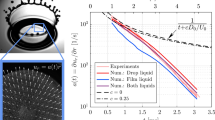Abstract
Some insects and animals, such as bugs, grasshoppers and tree frogs, realize their efficient adhesion mechanism to glass surface, wall and ceiling by injecting a wetting liquid thin film into the pad-substrate contact area. Their ability to control adhesion (attaching or detaching from a surface) is in many cases connected to the contact geometry and surface patterns of their attachment pads. This paper focuses on the dependence of the capillary adhesion (wet adhesion) on the micro patterns of the bio-adhesive pads. The objective is to reveal the possible mechanism for a bio-adhesive pad to control capillary force through adjusting its micro-scale surface pattern and topography. A capillary adhesion force model is built up taking account of the combined role of micro-dimple geometry as well as the wetting behavior of the confined liquid thin film. Calculated results of the apparent contact angle on the regularly micro-dimpled surfaces are compared with and in good agreement with the experimental measurements. Simulation of the capillary adhesion force reveals that it is controllable in a large magnitude by adjusting a dimensionless surface pattern parameter k defined as a/(a+b), where a is the diameter of micro dimple, and (a+b) is the side length of one pattern cell. When adjusting the parameter k more than 0.75, the capillary adhesion force could be switchable from attractive to repulsive. This effect of micro patterns on the interfacial capillary force is proved to be dominant when the pad-substrate clearance decreases to the nano/micrometer scale. These results indicate that a controllable and switchable capillary adhesive mechanism might be utilized by a living insect or animal to realize its stable adhesion and quick releasing movement through adjusting the micro-pattern topography of its bio-adhesive pad.
Similar content being viewed by others
References
Persson B N J. Wet adhesion with application to tree frog adhesive toe pads and tires. J Phys: Conden Matter, 2007, 19: 376110
Barnes W Jon P. Biomimetic solutions to sticky problems. Science, 2007, 318: 203–204
Persson B N J. Biological adhesion for locomotion on rough surfaces: Basic principles and a theoristis view. MRS Bulletin, 2007, 32: 486–490
Gorb S N, Sinha M, Peressadko A, et al. Insects did it first: A micropatterned adhesive tape for robotic applications. Bioinspir Biomim, 2007, 2: S117–S125
Persson B N J. On the mechanism of adhesion in biological systems. J Chem Phys, 2003, 118(16): 7614–7621
Barnes W J P. Functional morphology and design constraints of smooth adhesive pads. MRS Bulletin, 2007, 32: 479–485
Scherge M, Gorb S. Biological Micro and Nanotribology: Nature’s Solutions. Berlin: Springer-Verleg, 2004
Drechsler P, Federle W. Biomechanics of smooth adhesive pads in insects: Influence of tarsal secretion on attachment performance. J Comp Phys A, 2006, 192: 1213–1222
Chan E P, Greiner C, Arzt E, et al. Designing model systems for enhanced adhesion. MRS Bulletin, 2007, 32: 496–503
Smith J M, Barnes W Jon P, Downie J R, et al. Structural correlates of increased adhesive efficiency with adult size in the toe pads of hylid tree frogs. J Comp Phys A, 2006, 192: 1193–1204
Dai Z D, Gorb S N. Study on the micro-structure of Locustifs pad and FEM analysis of its contact (in Chinese). J Shanghai Jiaotong Univ, 2003, 37(1): 66–69
Dai Z D, Tong J, Ren L Q. Researches and developments of biomometics in tribology. Chinese Sci Bull, 2006, 51(22): 2681–2689
Tian Y, Pesika N, Zeng H B, et al. Adhesion and friction in gecko toe attachment and detachment. Proc Natl Acad Sci USA, 2006, 103: 19320
Sun J R, Dai Z D. Bionics of non-smooth surfaces (II) (in Chinese). Prog Nat Sci, 2008, 18: 727–733
Tiezzi P, Kao I. Modeling of viscoelastic contacts and evolution of limit surface for robotic contact interface. IEEE Trans Robot, 2007, 23(2): 206–217
Komvopoulos K. Adhesion and friction forces in microelectromechanical systems: Mechanisms, measurement, surface modification techniques, and adhesion theory. J Adhes Sci Tech, 2003, 17(4): 477–517
Packham D E. Surface energy, surface topography and adhesion. Int J Adhes Adhes, 2003, 23: 437–448
Marmur A. Wetting in porous media: some theoretical and practical aspects. Cont Angle Wett Adhes, 2003, 3: 373–383
Burton Z, Bhushan B. Hydrophobicity, adhesion, and friction properties of nanopatterned polymers and scale dependence for micro- and nanoelectromechanical systems. Nano Letters, 2005, 5(8): 1607–1613
Zhang X H, Zhang X J. Impact of confined liquid thin film upon bioadhesive force between insects and smooth solid surface (in Chinese). Acta Phys Sin, 2007, 56(8): 4722–4727
Cheng S. Study on the capillary adhesion force between micro-scale regularly modified Si surfaces (in Chinese). Master Degree Thesis. Beijing: Tsinghua University, 2006
Author information
Authors and Affiliations
Corresponding author
Additional information
Supported by the National Natural Science Foundation of China (Grant Nos. 50575123, 50730007), PPP Project from CSC and DAAD, and German Research Foundation (DFG) (Grant No. SFB622) (Y.H. Liu and S.I.-U. Ahmed)
About this article
Cite this article
Zhang, X., Liu, Y., Liu, Y. et al. Controllable and switchable capillary adhesion mechanism for bio-adhesive pads: Effect of micro patterns. Chin. Sci. Bull. 54, 1648–1654 (2009). https://doi.org/10.1007/s11434-009-0234-z
Received:
Accepted:
Published:
Issue Date:
DOI: https://doi.org/10.1007/s11434-009-0234-z




